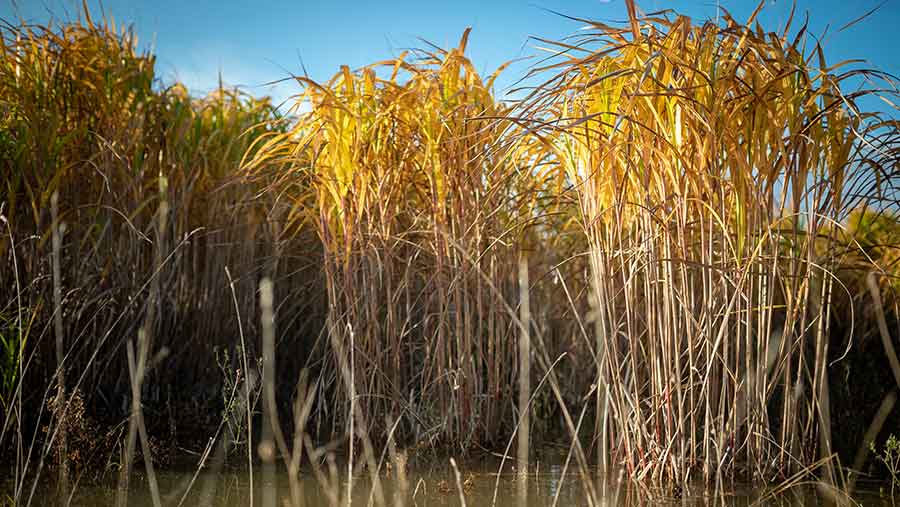Advertiser content
Miscanthus: The profitable solution for flood-prone fields
Provided by
Terravesta is the leading miscanthus supply chain specialist, producing sustainable energy from marginal land.
Miscanthus is a sustainable renewable energy crop and it grows on less productive land, which means it doesn’t compete with vital food production.
The Lincolnshire based company delivers a complete miscanthus supply chain solution for producers of the crop and works with over 300 UK growers, to serve several sustainable end markets, including power generation - both small and large scale.
To find out more about Terravesta, visit terravesta.com
As well as offering long-term, consistent income, and environmental benefits on less productive, flood prone or high-risk land, miscanthus is now more affordable and profitable, thanks to new Sustainable Farming Incentive (SFI) payments.
3 reasons why miscanthus is more affordable and profitable
- Payment before the first harvest – SFI payments of up to £2645 per year on a 10-hectare miscanthus crop can be claimed on land classified as a non-horticultural permanent crop.
- Quicker ROI – The net result of the income from miscanthus with SFI payments means the break-even point is two years earlier.
- Higher average net return – The average net return for a 10-hectare crop is £930/ha, and this return is retail price indexed, so it goes up consistently each year.
Crop specialist, Terravesta, offers growers long-term contracts to grow and sell the crop, which has an average lifespan of 15 years.
Miscanthus thrives on flood prone land, it stores 2.35 tonnes CO2e per hectare per year, it can help to stabilise flooded soils and receives no cultivation post-plating, bringing biodiversity benefits.
The crop requires no fertiliser, and while some weed control is advised during establishment, after the crop is established in year two, it requires minimal to no inputs.

© Terravesta
A solution for flood-prone land
Results of a study from the Institute of Biological Environmental and Rural Sciences (IBERS) at Aberystwyth University concluded that miscanthus can thrive on waterlogged fields, it provides soil stability and crop yield is not affected by excess water.
According to the lead author in the study, Dr Jason Kam, crop quality is not compromised by flooding.
“There is no significant difference in yield and other physiological development. Observed height and tiller number have no differences between winter flooded and non-flooded ground,” says Jason.
“Because of miscanthus’ perennial nature, annual planting is not needed. This therefore reduces soil disturbance to a minimum,” he says.
“The structure of miscanthus rhizome and root helps to stabilise soils, making it more resilient against flood-caused soil erosion,” adds Jason.
East Yorkshire farmer profiting with miscanthus on waterlogged land
East Yorkshire arable farmer, Rob Meadley, grows 12 hectares of miscanthus on varying quality, flood-prone land that previously wasn’t delivering a viable return with arable crops.
Rob planted miscanthus in March 2012 in good conditions, but this was followed by the wettest April on record, meaning the freshly planted crop was in standing water, and the bad weather hit again in June.
Rob explains that the 2014 harvest was affected by the legacy of flooding and lack of weed control.
“Arable crops would never have survived the conditions that the miscanthus was exposed to, and we didn’t lose any money on inputs.
The annual yield quickly recovered, and in 2017 and 2020, we had bumper harvests of over 13t/ha.”
Rob Meadley’s miscanthus harvest yields |
|||||||||||
|
2012 |
2013 |
2014 |
2015 |
2016 |
2017 |
2018 |
2019 |
2020 |
2021 |
2022 |
|
|
Tonnage |
– |
– |
9.78 |
100.66 |
143.64 |
157.54 |
139.94 |
153.41 |
159.36 |
134.61 |
154.25 |
|
Yield (Tonnes/ha) |
– |
– |
0.81 |
8.36 |
11.93 |
13.08 |
11.62 |
12.74 |
13.24 |
11.18 |
12.81 |
Ultimately, Rob explains that there would not have been another option for a crop on that land which would have been as profitable.
“Back in 2012 when we decided to plant miscanthus, the principle was looking at the whole farm net margin and identifying the risk in this area.
“It wasn’t performing as well as other parts of the farm and miscanthus was 100% the right decision for it.
“The only other option for that land would have been environmental grass, but miscanthus beats this hands down from a net margin point of view,” he adds.
Lincolnshire farmer growing miscanthus on fields that flood
Terravesta chairman, William Cracroft-Eley, planted a miscanthus crop in 2015 on flood-prone fields, having previously grown it in other areas on the farm.
When it came to the first harvest, the crop was 4 feet underwater due to flooding. The crop was left standing.
William left it until the following year and had a bumper harvest.
“It was a win-win situation, because no damage was done to the land, no money was spent on contractors, it wasn’t a loss, because we harvested the crop the following year with the new growth and we hadn’t spent any money on inputs because no fertiliser was applied,” he says.
“Miscanthus does well on all types of land, and like any crop, it does better on more favourable land.
“But, it also thrives where other crops fail, and this could be for numerous reasons, and in this case it’s become an ideal solution to water logged land which would otherwise be unprofitable,” says William.
Crop specialist, Terravesta, offers growers long-term, retail-index linked contracts to grow and sell the crop, which has an average lifespan of 15 years.
The company will supply Terravesta AthenaTM rhizomes, planting equipment and agronomy throughout the crop’s life, ensuring successful crop establishment under its planting promise, with establishment finance available from Oxbury, the Agricultural Bank.
